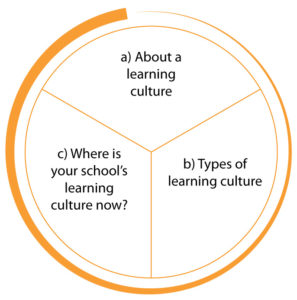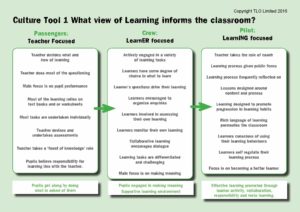Building better learners is about creating a culture in classrooms – and the school more widely – that systematically cultivates habits and attitudes that will stand pupils in good stead for a complex world.
This section introduces a range of classroom cultures, from traditional to learning centred, and invites you to consider and analyse the learning cultures of your school.
What is the most dominant learning culture in the school at present?
a) About a learning culture
Culture: all those little habits, routines and practices that implicitly convey ‘what we believe and value around here’. Classrooms are the places where, hour by hour, pupils experience the values and practices that are embodied in the school, rather than just the ones that are espoused.
Culture is about the micro-climate: what teachers do and say; what they notice and commend, or don’t; what kind of role model of learning they offer; how they design and present activities to build learning behaviours. Some classroom cultures are just more learning friendly than others.
What do we mean by learning culture ?
b) Types of learning culture
Research by Chris Watkins back in 2004 suggested three types of classroom learning cultures, some more learning friendly than others.
- Teacher centred; overriding emphasis on what the teacher is doing or saying.
- Learning = being taught.
- Pupils are passengers
- Pupils have an impoverished view of their learning ability.
- Learner centred; pupils take a more active role in deciding what to do.
- The learning is making meaning.
- Pupils are crew
- Pupils collaborate and discuss learning
- Learning centred; pupils learn about learning itself.
- Pupils use a language of learning.
- Become conscious of the learning process and the learning habits they command.
- Pupils are pilots of their learning
Hence there are often two strategic shifts to make in the journey from Teacher centred to Learning centred cultures. Teacher centred cultures may well achieve good results but only Learning centred cultures achieve good results PLUS curious, creative, self-regulating, independent learners.
Learning shift
Types of classroom cultures
c) Where is your school’s learning culture now?
The Culture Tool 1 gives more detail about each of the classroom cultures.
Take a look at the resource and think about the school’s learning culture against the indicators in each panel.
- Reflect on the culture of each classroom
- Highlight all aspects of culture that are a regular feature in each classroom
- What are the similarities and differences between phases, year groups, individual classes?
- What is this telling you?
Analyse the school’s current learning culture

- Which panels have most statements highlighted?
- Does this alter from phase to phase?
- What does this imply?
- Which statements in the middle panel would you most want to work on?
- Which statements in the right hand panel need to be worked on first?
- It’s worth remembering that the more teacher centred the school the longer the journey to a learning friendly culture.





Comments are closed.